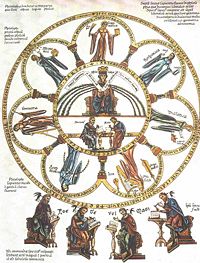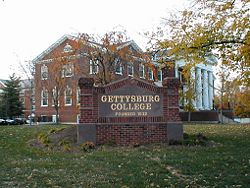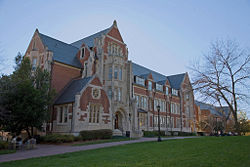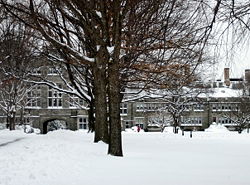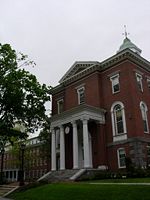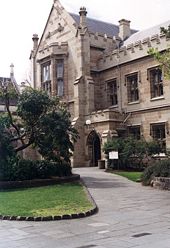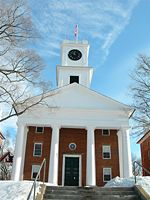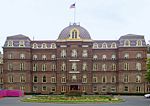Liberal arts college
| Schools |
|---|
| Education |
| History of education |
| Pedagogy |
| Teaching |
| Homeschooling |
| Preschool education |
| Child care center |
| Kindergarten |
| Primary education |
| Elementary school |
| Secondary education |
| Middle school |
| Comprehensive school |
| Grammar school |
| Gymnasium |
| High school |
| Preparatory school |
| Public school |
| Tertiary education |
| College |
| Community college |
| Liberal arts college |
| University |
Liberal arts colleges are post-secondary educational institutions which focus on a Liberal Arts curriculum, generally in undergraduate studies. Although the genesis for what is known today as the liberal arts college began in Europe, the term is commonly associated with the United States, where the largest concentration of liberal arts schools is to be found. With their vision of educating the whole student, emphasis on education for its own sake rather than for job preparation, and valuing the idea of community, they have played a significant role in American education and society. Liberal arts colleges, or colleges providing a liberal arts education, are to be found throughout the world today, albeit in smaller numbers than in the United States.
Usually small, liberal arts colleges provide an environment and educational program that allow students to develop their unique abilities and talents so that they can best serve society as educated adults. Originally designed for the elite of society, the thinkers and leaders rather than the workers, for whom vocational training is appropriate, liberal arts colleges have maintained selectivity in their admissions. Many were founded as single-gender institutions, including a number for women—notably the Seven Sisters Colleges—which provided excellent opportunities for young women to pursue quality higher education, as well as a number of prestigious men's institutions. This selectivity has been a strength, allowing them to develop a close sense of community; however, in contemporary society there is a perceived need for greater diversity.
History
The origin of liberal arts colleges is found in Europe.[1] The term "liberal" in "liberal arts" is from the Latin word liberalis, meaning "appropriate for free men" (social and political elites), and they were contrasted with the "servile arts." The "liberal arts" thus initially represented the kinds of skills and general knowledge needed by the elite echelon of society, whereas the "servile arts" represented specialized tradesman skills and knowledge needed by persons who were employed by the elite.
In the history of education, the seven liberal arts comprised two groups of studies: the trivium and the quadrivium. Studies in the trivium involved grammar, dialectic (logic), and rhetoric; and studies in the quadrivium involved arithmetic, music, geometry, and astronomy. These liberal arts made up the core curriculum of the medieval universities. Liberal arts curricula in Europe started to broaden during the age of the Renaissance, when the most famous and celebrated of the day, such as Leonardo Da Vinci, chose not to focus entirely upon one course of study or work, but to cross disciplinary lines consistently and study a variety of pursuits. Liberal arts came to mean all studies that impart a general, as opposed to a vocational or specialized, education. This tradition lived on in European educational institutions for some time after the Renaissance. However, during the Industrial Revolution, when technology was pushing the workforce to attain a specific set of skills, emphasis was once again placed upon educating the masses in a way that helped economic progress, particularly in regards to engineering and other technology-based fields.
In the United States however, the Yale Report of 1828 was produced in reaction to demands from society for education to start preparing students for the changing times. The Yale committee which put the report together concluded that a liberal arts curriculum, in which students were prepared for many different aspects of life, was the most beneficial:
In laying the foundation of a thorough education, it is necessary that all the important mental faculties be brought into exercise. ... When certain mental endowments receive a much higher culture than others, there is a distortion in the intellectual character. The mind never attains its full perfection, unless its various powers are so trained as to give them the fair proportions which nature designed. ... In the course of instruction in this college, it has been an object to maintain such a proportion between the different branches of literature and science, as to form in the student a proper balance of character. ... Our object is not to teach that which is peculiar to any one of the professions; but to lay the foundation which is common to them all.[2]
As a result of this report, Yale became one of the first schools to adopt a liberal arts program, which was then mirrored by other schools in the U.S. Since its publication, The Yale Report of 1828 became the classic argument for a liberal education and liberal arts colleges in the United States.[3] However, it should be noted that at this early stage, liberal art schools were increasingly selective and expensive, so the vast majority of Americans did not benefit from this type of education. In fact, since its initial inception, liberal arts colleges in the U.S. have had a somewhat back and forth relationship with society.
In the mid-nineteenth century, Americans began traveling to Germany for doctoral studies. The influx of German-educated scholars into to the United States bought a new model for higher education. Based on Enlightenment ideals of an all-round education and the critical research to discover truth that guided for the research intensive Humboldt University of Berlin, they created what is now the research university. Also at this time, technical and other schools focused on specific training, developed in the United States. These new types of colleges as well as the research model for the university were antithetical to the mission of the liberal arts college.
Many of the colleges that were founded on ideals closer to those of liberal arts colleges (such as Harvard, Princeton, and even Yale despite its earlier Report) became research universities. Other colleges, notably the historically women's Seven Sisters colleges, and the group (informally known) as the "Little Ivies" that includes such prestigious schools as Amherst, Bowdoin, Colby, Middlebury, Swarthmore, Wesleyan, and Williams, purposefully chose to remain small and committed to a liberal arts education. These elite institutions are noted as having "scaled the heights of prestige and selectivity and also turn away thousands of our best and brightest young men and women"[4]
During the latter half of the twentieth century, the rise in vocational, professional, and community colleges, along with research institutions, decreased the overall enrollment in liberal arts schools. In 2005, the Carnegie Classification of Institutions of Higher Education changed its "Basic Classification" scheme, first instituted in 1970 and the leading typology of all accredited colleges and universities in the United States, to reflect the increasingly complex and multifaceted landscape of higher education. Included in these revisions was the discontinuation of the use of the term "Liberal Arts College" as a sub-division of "Baccalaureate Colleges" in favor of a term that "more transparently describes the classification criteria" since both liberal arts college and liberal arts education are terms that "signify more than undergraduates' major field concentration."[5]
At the beginning of the twenty-first century, however, liberal arts schools were once again becoming more popular, which could be seen as a tendency in American society to have a workforce of both vocationally trained and liberal arts educated students.
Mission
In the United States, the designation of Liberal Arts College is given to schools that focus on giving its undergraduate students a multi-faceted education, requiring study of subjects that fall into the categories of humanities, social and physical sciences.[3] The purpose of this kind of education is to develop a well rounded student, who has the intellectual capacity to understand and utilize many different areas of intellectual thought and application. Liberal arts colleges provide:
an education in which students learn to learn, and education that emphasizes the forming rather than the filling of minds, an education that renders our graduates adaptive to any marketplace, curious about whatever world is around them, and resourceful enough to change with the times.[6]
However, most liberal arts colleges allow, and some insist, that in addition to general studies, most students should also declare a "major" of study, one area in particular upon which the student focuses and studies in more detail. For example, a liberal arts student who decides to major in Biology must still take foundation courses in other physical and social sciences, as well as humanities, but will likely progress upon a tiered system of more in-depth study to bring their understanding and experience in the field of biology to a higher level than any other part of the liberal arts curriculum. Majors are offered so that students are properly prepared either to enter the workforce with experience in a particular area or have completed the necessary coursework to continue their education in a more focused discipline. In addition, the liberal arts education model is regarded not just as producing academically well-rounded students, but also helps create citizens who are able to interact and contribute to a multifaceted and complex society.
Liberal arts colleges are known for being residential and for having smaller enrollment, class size, and teacher-student ratios than universities. These colleges also encourage a high level of teacher-student interaction at the center of which are classes taught by full-time faculty rather than graduate student TAs (who teach some of the classes at research universities). Most of the schools with this designation are private institutions, and tend to cost significantly more than state or public schools, continuing their elitism.
Organization and Administration
Most liberal arts colleges are small, privately run institutions. Some of these schools are affiliated with religious institutions, while others are secular based. Often times the schools receive little to no funding from public sources, but are financed through private endowments and the costs students and their families must pay in order to attend. While there is no set standard for private college administration, most schools have a President, Provost, Dean, or Chancellor who oversees the entire day-to-day operation and management of the school. In addition, most schools have a Board of Governors or Trustees, to whom the President or Dean must report. These schools are not bound by government mandates and are therefore allowed to develop and implement the curriculum and organization of their choosing. However, most schools follow suggested guidelines so as to be accredited by organizations that benefit the school and its image. One of the most important is the guidelines set by the United States Department of Education, which grants participation into financial aid programs to schools that follow its criteria.
Liberal arts colleges have often formed consortia, allowing them to pool their resources. Well-known consortia in the Eastern United States include the "Little Ivies," "Little Three," and the Seven Sisters Colleges. Four Eastern colleges, along with the University of Massachusetts Amherst, are also part of the Five Colleges Consortium in Western Massachusetts and three Eastern colleges comprise the Tri-College Consortium.
Similar consortia include the Claremont College Consortium in Southern California and the Associated Colleges of the Midwest in the Midwestern United States. Additional midwestern groups include the Five Colleges of Ohio, Associated Colleges of the Twin Cities, and the Great Lakes Colleges Association. Groups in the Southern United States include the Associated Colleges of the South, and the Seven Sisters of the South.
Most liberal arts schools have high academic standards for admission and look for students with well-rounded secondary educational experience that provides a good basis for entering a liberal arts program. Most often admissions requirements include letters of recommendation, an essay, good scores on standardized tests such as the SAT (Scholastic Aptitude Test) or ACT, a satisfactory high school grade point average (GPA), and sometimes an interview. While they do strive for the best possible students, some liberal arts colleges have instituted programs designed for students who do not meet the normal admissions requirements but can demonstrate the potential to benefit from attending their institution and therefore are granted admission. Most often, scholarships and grants are set aside for these students as the ability to pay for college is one of the largest barriers for potential students.
Some schools, such as Smith College and Bates College, have taken this approach even further, advocating for the SATs to be either optional or not used at all for determining admissions. The reason behind this move for is the long standing controversy that the SAT is culturally biased and that students from wealthy and middle class environments tend to do better than those from the lower socio-economic communities. Also in question is whether the test, which is used by most schools, is an accurate predictor of a student's abilities or success in college.[7] The counter argument to these claims is that there must be some standard used in determining college placement, and that College Board, which administers the SATs, continually adapts and changes the test to meet the needs of colleges and abilities of the students.[7] While a major break from the SATs by a majority of the liberal arts colleges is unlikely, such debate illustrates the changing attitudes with regard to education and the desire to allow a more diverse student population access to liberal arts programs.
Around the world
The designation liberal arts college is not used frequently outside the United States, but there are schools around the world that use a similar educational model. In Japan, the International Christian University was established after World War II as the first American-style college in Japan.[8] Germany has the European College of Liberal Arts,[9] and the Netherlands has founded three liberal arts colleges. In Ghana, Ashesi University College is modeled after the U.S. Liberal Arts system.[10] In Australia, Victoria University offers a two year "Diploma of Liberal Arts." Additionally, the University of Melbourne offers generalist undergraduate degrees similar to a liberal arts degree in the U.S.
There are many other schools in the world that do not designate themselves as liberal arts schools, but still teach a mixed curriculum of humanities and sciences, mostly in developed countries where educational institutions have long been established. In the developing world, there are fewer schools that follow a liberal arts curriculum, since most of their focus is on vocational schools so as to help the lower socio-economic class attain valuable work-related skills.
Notable Liberal Arts Colleges
The following is only a sample of the many liberal arts colleges in the U.S.
- Amherst College - Amherst is a private liberal arts college in Amherst, the third oldest college in Massachusetts. Established as a men's college, it has been coeducational since 1975. A small college, Amherst has been consistently ranked among the top, and on several occasions as the top, liberal arts college in the United States. It is a member of the Five Colleges consortium.
- Bennington College - Bennington College was founded in 1932 as a women's college focusing on arts, sciences, and humanities. It became co-educational in 1969. The campus was once a working dairy farm, and still affords a beautiful view of Vermont's Green Mountains. The college has long been known as a leader in progressive, student-centered education, with particular strengths in the creative and performing arts.
- Kings College - King's College is a highly-ranked Roman Catholic, private liberal arts college, located in downtown Wilkes-Barre, Pennsylvania. The college is administered by priests and brothers from the Congregation of Holy Cross, who are the founders of the University of Notre Dame, Stonehill College, and several other Catholic colleges in the United States.
- Smith College - A private, independent women's liberal arts college located in Northampton, Massachusetts. It is the largest member of the Seven Sisters and has supported the advancement of women in society, enabling them to receive the level of education that permits them to make significant impact in all arenas.
- Spelman College - A four-year liberal arts women's college in Atlanta, Georgia, founded in 1881 by Harriet E. Giles and Sophia B. Packard, the historically black institution began as the Atlanta Baptist Female Seminary, and was renamed Spelman Seminary in 1884 and Spelman College in 1924. Spelman is considered to be the top female historically black college in the United States.
- Thomas Aquinas College - A Roman Catholic liberal arts college offering a single integrated academic program. It is located in Santa Paula, California north of Los Angeles. It offers a unique education with courses based on the Great Books and seminar methodology.
- Trinity College - Trinity College is a private, selective liberal arts college in Hartford, Connecticut. Founded in 1823, it is the second oldest college in the state of Connecticut after Yale University, and is consistently ranked in the top 50 schools in the United States.
- Vassar College - Located in Poughkeepsie, New York, Vassar was originally founded as a women's college in 1861, and became the first member of the Seven Sisters to become coeducational. Vassar is consistently ranked among the top one percent of colleges and universities in the United States.
Notes
- ↑ Philip L. Harriman, "Antecedents of the Liberal-Arts College," The Journal of Higher Education 6(2) (1935): 63-71.
- ↑ The Yale Report of 1828 • Part I The Collegiate Way. Retrieved July 10, 2008.
- ↑ 3.0 3.1 Stacey A. Jacob, Liberal Arts Colleges Encyclopedia of Education (The Gale Group, 2002). Retrieved July 10, 2008.
- ↑ Howard Greene and Matthew Greene, Greenes' Guides to Educational Planning: The Hidden Ivies: Thirty Colleges of Excellence (HarperCollins, 2000, ISBN 0060953624).
- ↑ "Basic Classification Description" The Carnegie Foundation for the Advancement of Teaching 2007. Retrieved July 10, 2008.
- ↑ Michelle T. Myers, "Preparing Students for an Uncertain Future," Liberal Education 87(3) (2001): 22-26.
- ↑ 7.0 7.1 SAT Debate Online NewsHour with Jim Lehrer Transcript, March 30, 2001. Retrieved July 10, 2008
- ↑ History, International Christian University 2008. Retrieved July 10, 2008
- ↑ About ECLA, European College of Liberal Arts.
- ↑ Vision, Ashesi University College, 2008. Retrieved July 10, 2008
ReferencesISBN links support NWE through referral fees
- Greene, Howard, and Mathew W. Greene. Greenes' Guides to Educational Planning: The Hidden Ivies: Thirty Colleges of Excellence. New York, NY: HarperCollins, 2000. ISBN 0060953624
- Harriman, Philip L. "Antecedents of the Liberal-Arts College." The Journal of Higher Education 6(2) (1935): 63-71.
- Koblik, Steven and Stephen Richards Graubard. Distinctively American: The Residential Liberal Arts Colleges. 2000.
- Myers, Michelle T. "Preparing Students for an Uncertain Future." Liberal Education 87(3) (2001): 22-26.
- Pfnister, Allen O. "The Role of the Liberal Arts College." The Journal of Higher Education Vol. 55, No. 2 (1984): 145-170.
- Pope, Loren. Colleges That Change Lives: 40 Schools That Will Change the Way You Think About Colleges. New York, NY: Penguin, 2006. ISBN 978-0143037361
- Reeves, Floyd W. "The Liberal-Arts College." The Journal of Higher Education Vol. 1, No. 7 (1930): 373-380.
- Seidel, George. "Saving the Small College." The Journal of Higher Education Vol. 39, No. 6 (1968): 339-342.
- Staff of the Yale Daily News. The Insider's Guide to the Colleges. New York, NY: St. Martin's Griffin, 2007. ISBN 978-0312366896
External links
All links retrieved March 11, 2025.
- How To Choose a College That's Right For You - NPR
- The Seven Liberal Arts Catholic Encyclopedia
- Philosophy of Liberal Education
- The Center of Inquiry in the Liberal Arts
Credits
New World Encyclopedia writers and editors rewrote and completed the Wikipedia article in accordance with New World Encyclopedia standards. This article abides by terms of the Creative Commons CC-by-sa 3.0 License (CC-by-sa), which may be used and disseminated with proper attribution. Credit is due under the terms of this license that can reference both the New World Encyclopedia contributors and the selfless volunteer contributors of the Wikimedia Foundation. To cite this article click here for a list of acceptable citing formats.The history of earlier contributions by wikipedians is accessible to researchers here:
The history of this article since it was imported to New World Encyclopedia:
Note: Some restrictions may apply to use of individual images which are separately licensed.

